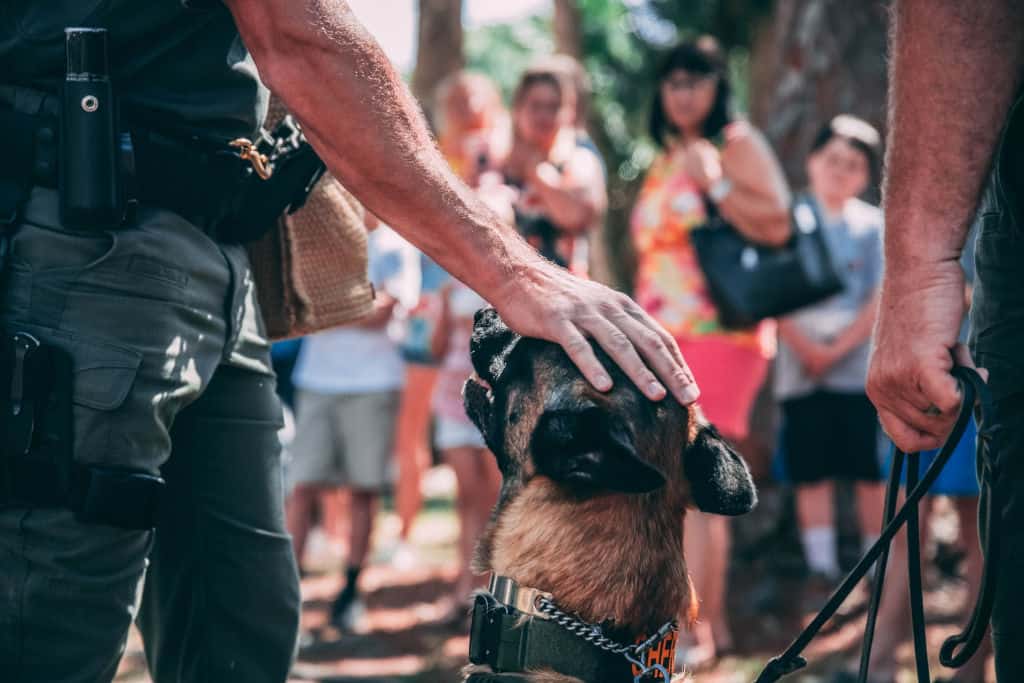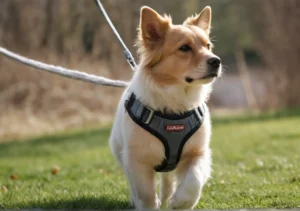Depending on the police department, you may have seen many K9s wear prong collars. Why would police use prong collars on their working dogs?
They are used to exert greater control over the K9 in high-risk circumstances or in huge groups where distraction is high, and safety is critical. The collar is also used to loosen a suspect’s bite and believe me, if you’re ever bitten, you’ll wish your dog wore a prong collar.
In many high-intensity situations, the question isn’t “Do police dogs use prong collars?” but rather “How effectively are they being utilized?”. Their application is, in many cases, an integral part of the handler’s strategy in managing their K9’s behavior amidst distractions.
When a suitable K9 is trained, they should be able to obey all commands without using a prong. Prongs are simply a training tool and, when used correctly, are effective. However, prong collars are only suitable for some dogs.

What Is the Practical Use of a Prong Collar?
They are intended to be used for quick snaps in unpleasant correction, with the premise that it simulates a mother correcting her pup. When utilized correctly, they can be terrific tools.
Unfortunately, not many people use them correctly or abuse their use. Therefore, prong collars get a negative reputation. It’s a good training tool as long as it’s used correctly and exclusively for training, not as a substitute for training.
I may use a prong as a tool for communication rather than correction. A prong collar gives more pressure and direction nuance than a flat collar, and many dogs benefit from this direct communication. We’ve mentioned prong collars in our dog collars guide.
Because dogs respond well to them when used appropriately, there is no need for an introductory period, and they may be withdrawn and phased out virtually immediately.
The most important aspect is that it allows me to apply as much pressure as possible on a dog while using little physical power. Some dogs are born with the ability to resist excessive pressure and will literally choke themselves out or seriously hurt their owner. Prong collars are significantly safer for the dog’s (and owner’s) safety.
You’re attempting to control the most vital section of the dog’s body while the dog’s attention is diverted elsewhere. Training with a collar that allows you to manage the head is far more effective.
The problem with positive punishment is that people frequently misapply it. Only some people will spend 4+ hours on YouTube watching different handlers use the equipment on other dogs, reading, and finding a training approach that suits their dog and their goals.
What Collars Do Police Dogs Use?
A wise handler introduces an e-collar to a K-9 as early in training as possible. They also utilize the e-collar with other training approaches, such as leashes and verbal or hand orders. Police may also choose not to neuter their male dogs, depending on the department.
If thinking of using a prong collar for yourself, be sure to pick a reputed brand of the prong, such as Herm Sprenger or Leerburg (for the micro ones).
However, not all “police dogs” in the United States are trained similarly. Many are imported and already prepared, while others buy trained canines from the United States, pay different trainers, or establish their in-house training programs.
Should Service Dogs Wear Prong Collars?
In the right hands, it can be a great tool. It is not a substitute for adequate training. It’s a tool that demands attention to detail and is dog-dependent.
Of course, incorrectly sized and used prongs will hurt a dog—the same as any other flat collar or headcollar. If there was scarring, it meant that something had gone wrong. They can, however, be used in a safe and healthy manner, which is why they are so helpful for service dogs.
The prong has greatly aided me in training a loose leash heel. However, it was highly damaging when I began working with my reactive dog. It’s a great tool, but it must be managed with caution, and don’t expect it to be a magical cure-all on its own.
When correctly set, prong collars do not choke the dog. They are a bit slack and only grasp tightly when pulled. This pronged hold will calm almost any dog and make them obedient, not because they are in pain, but because the circumferential “tooth grasp” induces innate submission.
It’s also vital to differentiate between different breeds and roles within the K9 unit. Some breeds may react differently to prong collars, and handlers often adjust their training tools accordingly.
Is It Cruel to Put Prong Collars on a Dog?
Arguments for the usage of prong collars go both ways.
On the one hand, many dog trainers will say that prong collars are not typically cruel as we think of them. They grab the neck circumferentially with blunt prongs, similar to how a mother dog might grip a puppy to calm and transport it. This procedure usually does not harm.
On the other hand, aversive approaches such as prong collars are not recommended by the American Veterinary Society of Animal Behavior. They’ve concluded that aversive training techniques harm animal welfare and the human-animal bond.
Some police dogs, but not all, are abused or neglected, and that’s true. But there are also far too many police dogs that are unstable or overly reactive, and they’re not as obedient as we might sometimes imagine.
Many dog trainers will say that prong collars are fine if introduced and used correctly, just like any other tool. Even more effective when combined with training and gradually phased away.
If you utilize them with a professional and have exhausted all other options, and that’s all it takes to handle your dog/exercise, the benefits outweigh the drawbacks.
Why do some people believe that attaching a prong collar to a dog is cruel? Perhaps people have had pets but have never had to train high-drive dogs. These people may need a perspective on the problem.
A pet may have the drive of a working dog, which is why a prong collar might be best for them. Similarly to e-collars, if appropriately used, prongs are not abusive.
Just as you should not need to reward a dog after training is strong constantly, training tools should not be a constant presence and should only be brought back if maintenance training has failed and you need to reinforce previous learning.
It’s worth noting that, when discussions arise about whether or not police dogs use prong collars, the focus should always shift from the tool itself to the methodology behind its use. A tool is only as humane or inhumane as the hand that wields it.
What Is Better Than a Prong Collar?
The broader K9 community constantly debates training methodologies. While some handlers swear by the efficiency of prong collars, others opt for alternative tools and techniques that they believe foster better communication with their canine counterparts.
First and foremost, nothing is one-size-fits-all. Second, you should always begin with positive reinforcement and keep trying. Only move on to the negative punishment when all other options have been exhausted.
Trying the prong collar at the start may not solve your pulling problem. Instead, go to the bottom of why your dog is tugging (excitement around others) and neutralize it.
For training, try Alice Tong’s engage/disengage game daily. Do this with whatever is causing your dog to respond. Once you’ve mastered the game, try practicing fundamental obedience cues such as sit, down, touch, focus, and so on around these triggers.
If utilized with care, it can be a beneficial tool. But, once again. Some high-drive, game dogs don’t care about leash corrections, and that’s fine. Make the decision that is best for you and your dog-owner team.
FAQs
Do vets recommend prong collars?
Since most people will misuse the collars, many veterinarians will advise against their use. Vets can’t predict who will use the collar properly and who won’t. In addition, vets aren’t dog trainers, so this question should be posed to dog trainers and animal behaviorists, not veterinarians.
Can you use a prong collar on a smaller dog?
Prong collars often have a wide enough range to fit any size dog, but they are typically available in three sizes: small 2.25mm, medium 3.0mm, and big 4.0mm. Smaller dogs may benefit from 2.25mm collars because these collars are made up of little links that are more vulnerable to unintentional opening.
Why do some dogs not respond well to prong collars?
There could be various reasons why the dog refuses to wear the prong collar. It’s usually because the prong collar isn’t adequately sized or fitted around the dog’s neck, or the person isn’t using it appropriately. Perhaps the prong was used as a band-aid in certain ways without the proper training.
Alex, a passionate animal lover, has experience in training and understanding animal behavior. As a proud pet parent to two dogs and three cats, he founded AnimalReport.net to share insights from animal experts and expand his knowledge of the animal kingdom.




